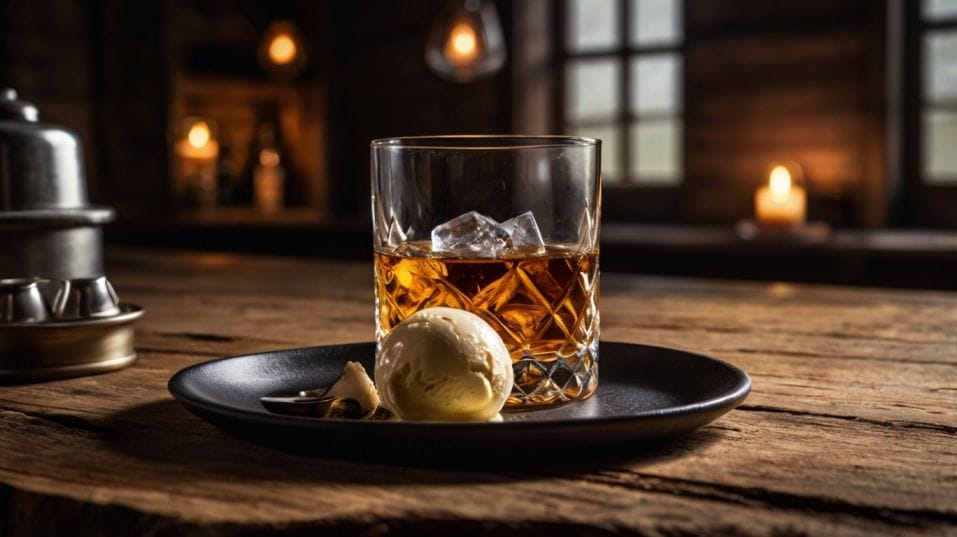Whiskey and Ice Cream: Yes, It’s a Thing
Level up your whiskey palate with a surprising tool: ice cream. Discover how contrast tasting builds clarity, memory, and collector confidence.

What if the secret to truly understanding whiskey... was in your freezer? If you’re getting serious about tasting—really tasting—whiskey, pairing it with ice cream might be the shortcut your palate didn’t know it needed.
This isn’t about dessert. It’s about contrast, clarity, and sharpening your senses. Used right, ice cream can train your brain to decode what’s in the glass—without the fluff, the gimmicks, or the guesswork.
Why Whiskey Needs Contrast
Most whiskey drinkers—especially early on—hit a wall. Every bourbon starts to taste like “oak and vanilla.” Every scotch starts to taste like “peat and smoke.” And if you don’t reset your palate, those shortcuts become blind spots.
Ice cream works because it gives you a contrast. It shifts your frame of reference, and suddenly the structure of the whiskey—its tannins, spice, esters, and finish—comes into sharper focus. The sweetness isn’t the point. The contrast is.
What’s Actually Happening on Your Palate
- Cold numbs and reactivates: Cold resets receptors and gives sharper clarity when you return to the dram.
- Fat coats, then clears: Dairy fat temporarily insulates taste buds from alcohol, letting subtler flavors step forward.
- Sugar balances ethanol burn: Sweetness downshifts harshness, helping you isolate structure.
- Texture gives feedback: Dense or creamy textures expose tannin and spice in sharper relief.
You’re not just tasting better—you’re teaching your palate how to interpret.

From Gimmick to Technique: Making It Work
This isn’t about pouring whiskey over ice cream or making “boozy floats.” That’s a dessert, not a tool. Real pairing is about separation—side-by-side tasting that leverages contrast, not sugar overload.
Start by choosing your whiskey. Neat. Room temperature. No water, no ice. Then pick a clean, focused ice cream—something that doesn’t scream for attention.
Best Pairing Ice Creams to Start With:
- Vanilla bean: amplifies oak, vanillin, and sweet grain notes in bourbon or malt.
- Salted caramel: sharpens rye spice and finishes in grain-forward whiskeys.
- Dark chocolate or cocoa: reveals earthy, bitter, or leathery depth in smoky or sherry-aged pours.
- Espresso or mocha: plays well with heavily charred barrels, older bourbon, or peated scotch.
- Citrus or stone fruit sorbets: wakes up floral, estery components in young or light whiskies.
Avoid overloaded mix-ins. No fudge swirls, no birthday cake chunks. You want clarity—not chaos.
Practical Tasting Method: Taste, Reset, Repeat
Once you’ve got your pairing, here’s how to use it effectively.
Step-by-Step (Without Turning It Into a Ritual):
- Take a neat sip. Let it sit on the tongue for a few seconds. Swallow and breathe out gently through your nose. Notice what you taste—then let it go.
- Spoon the ice cream. Let it melt slightly on your tongue. Swallow. Feel what textures and flavors linger.
- Return to the whiskey. Take another small sip. Do the same thing—but this time, pay attention to what’s changed. What’s clearer? What shows up that didn’t before?
Repeat this slowly. You’re not trying to finish either the pour or the scoop. You’re trying to build a sensory map—and that takes space between steps.
What Beginners Get Wrong (and How to Fix It)
Tasting isn’t about being poetic. It’s about being specific.
When someone says a whiskey “tastes like campfire and leather,” that’s meaningless if you’ve never trained your brain to recognize those cues. Ice cream gives you a tactile, emotional reference point.
Common Mistakes:
- Treating it like dessert: You’re not here for indulgence. Keep the portion small and the focus tight.
- Using overly sweet flavors: High sugar content overwhelms nuance. You’re not numbing—you’re dissecting.
- Jumping between whiskeys: Stick to one bottle per session. Learn that pour.
- Eating and drinking too fast: You’re teaching your brain. That takes time, silence, and repeat exposure.
Palate Memory: Why It Matters
Most casual drinkers only remember what they liked, not what they tasted. But serious tasters build a sensory vocabulary—one that helps them identify quality, track changes in a bottle over time, and buy with confidence instead of guessing.
What Ice Cream Does for Sensory Training:
- Anchors known flavors: You’ll start recognizing vanillin, cocoa, citrus oil, and cream as base notes in whiskey.
- Teaches contrast: It highlights highs and lows—showing how flavor curves move through heat, mid-palate, and finish.
- Reveals flaws: Too much bitterness? Off-dry finish? Ice cream pulls those imperfections to the front.
That’s how you train for consistency. Not just tasting more—but tasting better.
Collect Smarter Through Sensory Feedback
Once your palate gets sharper, collecting changes. You’re no longer chasing age statements or bottle hype. You’re chasing flavor architecture—how structure, finish, and balance play out over time.
You’ll also get better at noticing oxidation, bottling proof, barrel finish types, and other variables that affect quality. Why? Because your palate knows what clean, sharp contrast feels like. Ice cream taught it.
Final Thoughts
Whiskey and ice cream isn’t a stunt. It’s a skill. One that builds clarity, contrast, and memory in a way most casual drinkers never access. It trains your taste and builds your confidence—without ego, trend-chasing, or twenty open bottles.
So skip the gimmicks. Find a bottle you think you know. Grab a scoop of real vanilla bean or cocoa gelato. Sit down. Taste slowly. Repeat with intent.
You’ll walk away tasting more, collecting smarter, and drinking whiskey like someone who actually understands what’s in the glass.
Try it tonight. Train your palate. Build your confidence—one spoon and one sip at a time.




